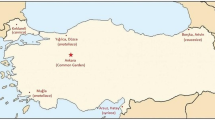Abstract
Following antennal contact with the honeydew of the black scale (Saissetia oleae Olivier), female adult green lacewings (Chrysoperla carnea Stephens) showed a reduced mean walking speed (inverse orthokinesis), an increased mean turning frequency (positive klinokinesis), and an increased mean turning angle. Similar, but generally less pronounced, behavioural changes occurred after contact with solutions of acid hydrolysed L-tryptophan and water. Reduced walking speed, lower mean turning frequency and increased mean turning angle were also observed in insects exposed to honeydew during the period prior to antennal contact with the honeydew. The observed alterations in behaviour in response to honeydew could increase the likelihood of both honeydew and prey being located in the field.
Résumé
A la suite d'un contact antennaire avec le miellat de la cochenille noire (Saissetia oleae), les femelles adultes deChrysoperla carnea Stephens présentent une vitesse de déplacement moyenne réduite (orthokinèse inverse), une fréquence de changement de direction moyenne accrue (klinokinèse positive), et une augmentation de l'angle de changement de direction moyen. De manière similaire mais généralement moins accentuée, des changements de comportement se manifestent après contact avec des solutions de L-triptophane hydrolysé en milieu acide. Une vitesse de déplacement réduite, une fréquence moyenne de changement de direction plus faible et un angle de changement de direction moyen en augmentation sont également observés chez les insectes exposés au miellat durant la période précédant un contact antennaire avec le miellat. Les altérations de comportement observées en réponse au miellat pourrait allonger la vie à la fois du miellat et de la proie dans la nature.
Similar content being viewed by others
References
Alrouechdi, K. — 1980. Les chrysopides en verger d'oliviers. Bio-écologie deChrysoperla carnea (Stephens) (Neuroptera: Chrysopidae); relations comportementales et trophiques avec certaines espèces phytophages. Doctoral Thesis, Paris.
Budenberg, W. J. — 1990. Honeydew as a contact kairomone for aphid parasitoids. —Entomol. exp. appl., 55, 139–148.
Carter, M. C. &Dixon, A. F. G. — 1984. Honeydew: an arrestant stimulus for coccinellids. —Ecol. Entomol., 9, 383–387.
Dean, G. J. &Satasook, C. — 1983. Response ofChrysoperla carnea (Stephens) (Neuroptera: Chrysopidae) to some potential attractants. —Bull. Ent. Res., 73, 619–624.
Duelli, P. — 1980. Adaptive dispersal and appetitive flight in the green lacewingChrysopa carnea. —Ecol. Ent., 5, 213–220.
Duelli, P. — 1984. Oviposition. In:Biology of Chrysopidae, Series Entomologica 27 (M. Canard Y. Séméria &T. R. New, eds.). —Junk, The Hague: 129–133.
Duelli, P. — 1987. The influence of food on the oviposition-site selection in a predatory and a honeydew-feeding lacewing species (Planipennia: Chrysopidae). —Neuroptera Int., 4(3), 205–210.
Elbadry, E. A. &Fleschner, C. A. — 1965. The feeding habits of adults ofChrysopa californica Coquillett.Bull. Soc. Ent. Egypte, 29, 359–366.
Hagen, K. S. — 1950. Fecundity ofChrysopa californica as affected by synthetic foods. —J. Econ. Entomol., 43, 1: 101–104.
Hagen, K. S., Greany, P., Sawall, E. F. Jr. &Tassan, R. L. — 1976. Tryptophan in artificial honeydews as a source of an attractant for adultChrysopa carnea. —Environ. Entomol., 5, 458–468.
Jervis, M. A., Kidd, N. A. C., McEwen, P., Campos, M. &Lozano, C. — 1992. Biological Control Strategies in Olive Pest Management. In: Research Collaboration in European IPM Systems. BCPC Monograph No. 52 (P. T. Haskell, ed.). —British Crop Protection Council, Farnham: 31–39.
Johnson, C. G. — 1969. Migration and Dispersal of Insects by Flight.Methuen, London.
Kennedy, J. S. — 1978. The concepts of olfactory “arrestment” and “attraction”. —Physiol. Entomol., 3, 91–98.
McEwen, P. K., Jervis, M. A. & Kidd, N. A. C. — 1993. Use of a sprayed L-tryptophan solution to concentrate numbers of the green lacewing,Chrysoperla carnea, in olive tree canopy. —Entomol. exp. appl. (in press).
Principi, M. M. &Canard, M. — 1984. Feeding Habits. In: Biology of Chrysopidae (M. Canard, Y. Semeria &T. R. New, eds.). —Junk, The Hague: 76–92.
Sheldon, J. K. &MacLeod, E. G. — 1971. Studies on the Biology of Chrysopidae, 2. The feeding behaviour of the adult ofChrysopa carnea (Neuroptera). —Psyche, 78, 107–121.
van Emden, H. F. &Hagen, K. S. — 1976. Olfactory reactions of the green lacewingChrysopa carnea to tryptophan and certain breakdown products. —Environ. Entomol., 5, 469–473.
van den Meiracker, R. A. F., Hammond, W. N. O. &van Alphen, J. J. M. — 1990. The role of kairomones in prey finding byDiomus sp. andExochomus sp., two coccinellid predators of the cassava mealybug,Phenacoccus manihoti. —Entomol. exp. appl., 56, 209–217.
Author information
Authors and Affiliations
Rights and permissions
About this article
Cite this article
McEwen, P.K., Clow, S., Jervis, M.A. et al. Alteration in searching behaviour of adult female green lacewingsChrysoperla carnea (Neur.: Chrysopidae) following contact with honeydew of the black scaleSaissetia oleae (Hom.: Coccidae) and solutions containing acidhydrolysed L-tryptophan. Entomophaga 38, 347–354 (1993). https://doi.org/10.1007/BF02374452
Received:
Accepted:
Issue Date:
DOI: https://doi.org/10.1007/BF02374452




